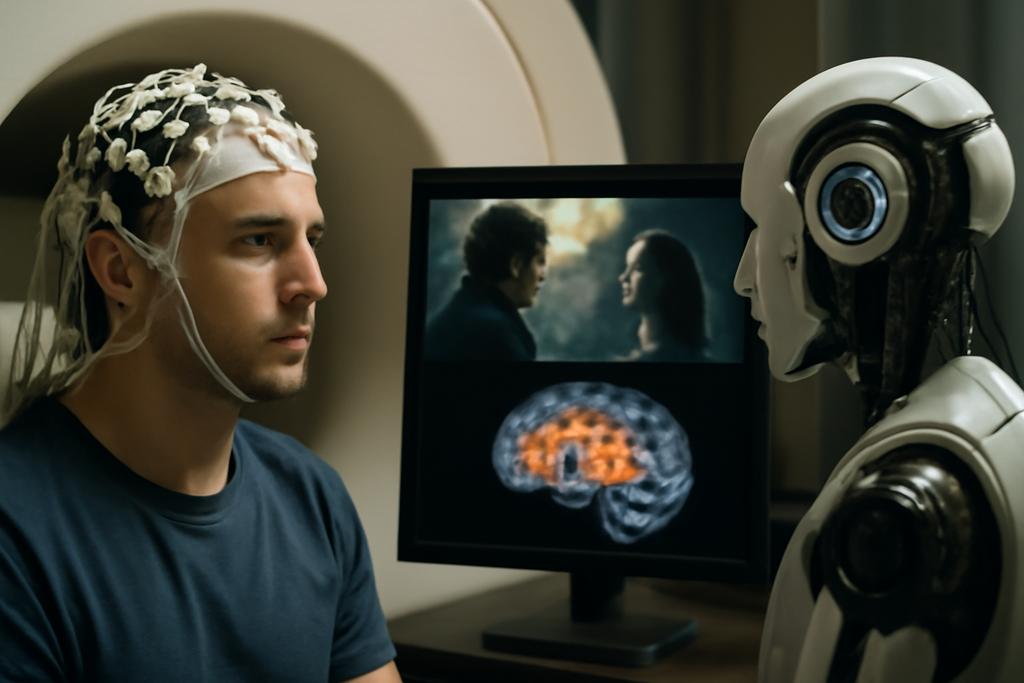Forget mind-reading; scientists are now building AI that can predict how your brain responds to movies. This isn’t some futuristic fantasy – it’s happening now, thanks to a groundbreaking study by researchers at the Max Planck Institute for Human Cognitive and Brain Sciences, led by Semih Eren, Deniz Kucukahmetler, and Nico Scherf. Their work, part of the Algonauts 2025 challenge, pushes the boundaries of what’s possible in understanding the intricate relationship between our brains and the rich, sensory experiences of everyday life.
Decoding the Brain’s Movie Marathon
The team’s achievement is nothing short of remarkable: they’ve created an AI system capable of anticipating your brain’s activity while you watch a movie. The secret lies in a sophisticated algorithm that doesn’t just look at the visual elements on screen – it processes the sights, sounds, and even the dialogue of the film simultaneously. Think of it as a superpowered movie critic that’s intimately tuned to the neural responses in your brain. This multimodal approach is key, as it allows the AI to recognize complex interplay of sensory inputs that shape the way we engage with movies.
The model’s architecture is remarkably clever. It’s a multi-layered neural network that functions like a well-oiled machine, assembling information from various sources. First, it feeds on pre-trained AI models specializing in understanding images (SlowFast, VideoMAE, Swin Transformer, and CLIP), sounds (HuBERT, WavLM, and CLAP), and language (BERT and Longformer). These models act as specialized interpreters, extracting the essence of the visual, auditory, and linguistic aspects of a movie clip.
Next, these individual interpretations are interwoven in a process of recurrent neural network (RNN) encoding. RNNs are perfect for handling sequential data—the way a movie unfolds moment by moment. The model then synthesizes these interwoven streams of information to create a unified representation of the movie clip. This composite understanding is, in turn, used to predict the brain’s response.
It’s not enough to understand the movie; the model must also understand the viewer. To do this, the model employs subject-specific prediction heads— essentially, a personalized adjustment for each person’s unique way of processing the movie experience. This level of personalization shows the true power of this approach.
More Than Just Correlation: A Deeper Understanding
The team didn’t just build a model; they also devised innovative training methods. One notable approach is their curriculum learning strategy. The model isn’t trained on all aspects of brain activity at once. Instead, it starts by learning to predict responses in the primary sensory areas of the brain—the parts that first process visual and auditory input. Once it masters this, it gradually extends its predictive power to higher-order brain regions that handle more complex cognitive functions. Think of it like learning to walk before running a marathon; the approach is both clever and effective.
Another key element is the use of an ensemble of models. Instead of relying on a single model, the researchers trained a hundred variations, each slightly different. The average output of these models gives a more robust and accurate prediction. This ensemble approach is like having a panel of experts, each offering their perspective before reaching a final consensus.
The results are impressive. The researchers’ model ranked third in the Algonauts 2025 challenge, achieving a commendable Pearson correlation coefficient of 0.2094 between the predicted and actual brain activity. While this might not seem like a high score at first glance, in the context of predicting brain responses to naturalistic stimuli, it’s a significant leap forward. The score reflects a surprisingly accurate prediction, especially considering the complex and dynamic nature of the human brain. This metric shows a high level of accuracy, especially considering the dynamic and complex nature of the human brain.
Why This Matters: Beyond the Numbers
The implications of this research extend far beyond just understanding how we process movies. It offers a powerful tool for investigating a vast array of brain processes and cognitive functions. Imagine the possibilities in studying how we react to other dynamic stimuli – not just movies, but real-world situations, even our own internal thoughts and feelings. This technology could unlock a treasure trove of insights into our mental landscape.
Furthermore, the multimodal approach – integrating visual, auditory, and linguistic information – provides a framework for future research that could lead to more sophisticated and personalized diagnostic tools. By studying brain responses to various stimuli, we might be able to detect subtle changes that indicate the onset of neurological disorders, paving the way for early intervention and more effective treatments. The potential for improving healthcare is enormous.
However, the study also highlights certain limitations. The model’s performance is not uniformly strong across all areas of the brain, with the prefrontal cortex proving particularly challenging. This limitation underscores the need for further refinement and improvement. The researchers have already identified several avenues for future research, including refining the model’s handling of language and investigating more advanced neural network architectures. It’s an ongoing journey of discovery, with each step bringing us closer to a much richer understanding of the human brain.
A Glimpse into the Future
The research by Eren, Kucukahmetler, and Scherf marks a significant milestone in the field of neuroimaging and artificial intelligence. The development of an AI system capable of accurately predicting brain responses to complex, naturalistic stimuli opens exciting new avenues for investigating the human mind. It’s a journey that will undoubtedly yield both astonishing discoveries and significant technological advances in the years to come.










